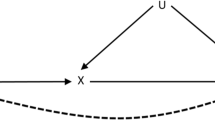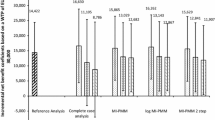Abstract
Background: Missing data resulting from premature study withdrawal are a common problem in the analysis of longitudinal data in clinical trials. To date, this subject has received little attention in the context of economic evaluations and with regard to the analysis of cost data.
Objectives: To (i) demonstrate the impact of patients who drop out during the study on the outcomes of an economic evaluation, and (ii) to compare the mean and variation in costs after applying five different methods to deal with incomplete data: multiple imputation, complete cases analysis, linear extrapolation, predicted mean and hot decking.
Study design: The study was performed using cost data collected in two randomised clinical trials comparing patients with chronic obstructive pulmonary disease receiving either tiotropium bromide or ipratropium bromide. The overall dropout rate was 17%, with the daily costs of the dropouts approximately 4 times higher than the costs of the completers.
Methods: Multiple imputation is a principled method that deals with missing observations by replacing each missing observation with a set of multiple plausible values. The variance between the resulting multiple datasets is combined with the variance between the datasets to take account of the extra uncertainty that results from missing data. The outcomes after multiple imputation were compared with the results of four naive methods to deal with missing observations: complete cases analysis, linear extrapolation, predicted mean and hot decking. All costs were expressed in 2001 euros.
Results: In the tiotropium bromide group, mean (standard error) costs varied from €955 (137) after complete cases analysis to €1298 (198) after linear extrapolation. The corresponding estimates in the ipratropium bromide group were €970 (125) and €1561 (244), respectively. The difference in costs between treatment groups varied from -€15 (95% CI: -379 to 349) after complete cases analysis to -€402 (95% CI: -883 to 79) after predicted mean, in favour of the tiotropium bromide group. The difference in costs according to the other methods varied from -€263 (95% CI: -878 to 353) after linear extrapolation to -€265 (95% CI: -709 to 180) after multiple imputation to -€359 (95% CI: -771 to 54) after hot decking.








Similar content being viewed by others
References
Barber JA, Thompson SG. Analysis and interpretation of cost data in randomised controlled trials: review of published studies. BMJ 1998; 317: 1195–200
Rutten-van Mölken MPMH, Doorslaer EKAv, Vliet RCJA. Statistical analysis of cost outcomes in a randomized controlled clinical trial. Health Econ 1994; 3: 333–45
Schafer J. Analysis of incomplete multivariate data. London: Chapman & Hall, 1997
Little R, Rubin D. Statistical analysis with missing data. New York: Wiley, 1987
Rubin D. Multiple imputation for nonresponse in surveys. New York: Wiley, 1987
Zeger SL, Liang KY. Longitudinal data analysis for discrete and continuous outcomes. Biometrics 1986; 42: 121–30
Lin D, Feuer E, Etzioni R, et al. Estimating medical costs from incomplete follow-up data. Biometrics 1997; 53: 419–34
Oostenbrink JB, Rutten-van Mölken MPMH, Al MJ, et al. Oneyear cost-effectiveness analysis of tiotropium versus ipratropium for the treatment of COPD. Fur Respir J. In press
Pauwels RA, Buist S, Calcerley PMA, et al. Global strategy for the diagnosis, management, and prevention of chronic obstructive pulmonary disease. Am J Respir Crit Care Med 2001; 163 (5): 1256–76
Jones PW, Quirk FH, Baveystock CM. The St. George’s Respiratory Questionnaire. Respir Med 1991; 85 (Suppl. B): 25–31
Vincken W, van Noord JA, Greefhorst AP, et al. Improved health outcomes in patients with COPD during 1 year’s treatment with tiotropium. Fur Respir J 2002; 19 (2): 209–16
Rubin D, Schenker N. Multiple imputation in healthcare databases: an overview and some applications. Stat Med 1991; 10: 595–8
Lavori P, Dawson R, Shera D. A multiple imputation strategy for clinical trials with truncation of patient data. Stat Med 1995; 14: 1913–25
O’Callaghan F. A multiple imputation strategy for missing data in longitudinal studies. Kwantitatieve Methoden 1999; 62: 111–22
Acknowledgements
The study was funded by Boehringer Ingelheim GmbH. The authors have no conflicts of interest that are directly relevant to the content of this manuscript.
Author information
Authors and Affiliations
Corresponding author
Rights and permissions
About this article
Cite this article
Oostenbrink, J.B., Al, M.J. & Rutten-van Mölken, M.P.M.H. Methods to analyse cost data of patients who withdraw in a clinical trial setting. Pharmacoeconomic 21, 1103–1112 (2003). https://doi.org/10.2165/00019053-200321150-00004
Published:
Issue Date:
DOI: https://doi.org/10.2165/00019053-200321150-00004




